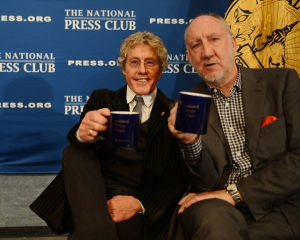Sarah Sterner did not want clowns with ukuleles in her hospital room.
Sterner, a high-school sophomore at the time, was diagnosed with a brain tumor three years ago. The drugs her doctors prescribed made her too woozy to go to school, so she spent her days at home doing coursework online. With her parents at work and her friends in class, “I was very lonely,” Sterner, now 18, recalled.
Her sense of isolation didn’t go away during medical treatment that took place in pediatric health units. She felt too old for those places, she said, especially when music-playing clowns would visit her room. “They’d come in dressed up as I was being tested, with the ukuleles and spoons, and I was like, ‘Really? I’m 15,’” Sterner said.
 Sterner described her experience as a teenager with cancer at the National Press Club in Washington, D.C., earlier this month to illustrate why adolescents with cancer can feel particularly alienated in medical environments that either cater to children or to full-grown adults. She spoke alongside British rock legends Roger Daltrey and Pete Townshend of The Who (pictured left), who have emerged as passionate advocates for creating hospital spaces that cater to the needs of adolescents with cancer.
Sterner described her experience as a teenager with cancer at the National Press Club in Washington, D.C., earlier this month to illustrate why adolescents with cancer can feel particularly alienated in medical environments that either cater to children or to full-grown adults. She spoke alongside British rock legends Roger Daltrey and Pete Townshend of The Who (pictured left), who have emerged as passionate advocates for creating hospital spaces that cater to the needs of adolescents with cancer.
Daltrey and Townshend were in the United States for the announcement of a new teen cancer ward at Ronald Reagan UCLA Medical Center, which they say will be the first program of its kind in the nation. The now middle-aged Daltrey and Townshend regularly play charity concerts to raise funds for the Teen Cancer Trust, a British charity that has over the last 10 years raised funds to create 23 adolescent cancer units within nationalized health service facilities all over the United Kingdom.
The units include common living areas with computers, game consoles and televisions, and kitchen facilities so patients can cook for themselves. They allow teens and their parents to socialize and share their experiences, and to keep up with schoolwork, Daltrey said. The UCLA teen cancer ward, which is still in its design phase, will be modeled after these units.
“Teenagers love to be together. They LOVE to be together. You know, the parties you used to have with all your mates? Teenagers with cancer want to do the same thing,” Daltrey said in a passionate address at the Press Club. “They need a little bit of space in a hospital – not a great deal, just a little — where they can make a little noise, they can have MTV, they can have computers.”
Teenage often get the most aggressive and fastest-growing types of cancer because of their hormonal changes, Daltrey said. To make things worse, they are often diagnosed late because they’re too busy for medical visits and because few doctors think of cancer as a possibility for their age group, he added.
Just being able to meet others going through the same thing can make the experience of having cancer a little easier to bear, Daltrey said. He described a recent visit to a medical center at Yale University, where he saw three teenagers with cancer lying in bed in three different rooms.
“There they were, three boys, three separate rooms, three sets of parents, none of them knew they were next door to each other. Yale immediately recognized the issue,” he said. “It’s just a matter of juggling the balls and getting them in the right place.”
Researchers are still studying the impact of such an environmental and social change on teenagers with cancer, but indications so far are that survival rates for teens improve by as much as 10 to 15 percent if they have access to these kinds of cancer units, Daltrey said.
For Sterner, the feeling that nobody her age really understood what she was going through only lifted once she began to correspond with a local football player with a brain tumor. She reached out to him after reading about him in a newspaper. Their correspondence made her feel better and less alone.
“When your emotional health is better, your physical health is going to be better,” Sterner said. “Being a survivor of 2.5 years, I’m a firm believer in that.”
Photo from The National Press Club by Christy Bowe.






























